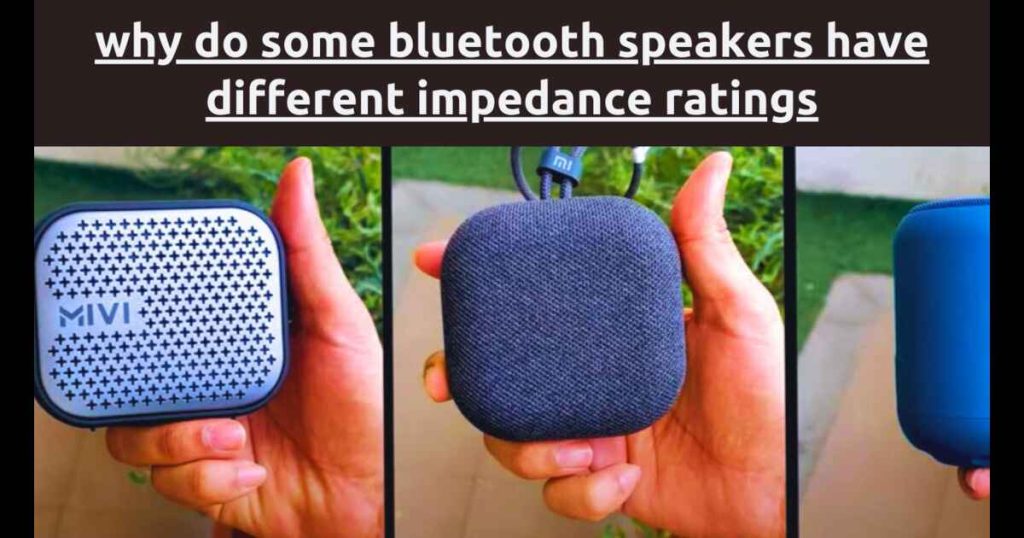
Bluetooth speakers, renowned for their wireless convenience and immersive sound, often showcase diverse impedance ratings across different models and brands. The variations in these impedance ratings contribute to nuanced differences in audio performance. In this article, we delve into the underlying reasons behind the diverse impedance ratings found in Bluetooth speakers, shedding light on the factors driving this variability.
Also read our comprehensive guide on impedance of Bluetooth speaker and Advantages of Using High-impedance Bluetooth Speakers.
Why Do Some Bluetooth Speakers Have Different Impedance Ratings?
Ever wondered! Why do some Bluetooth speakers have different impedance ratings? Diving into the realm of Bluetooth speakers, one might notice a curious trend: the diverse range of impedance ratings among these devices. It’s a fascinating puzzle to uncover why certain Bluetooth speakers showcase varying impedance ratings. Join me on this journey into the world of audio technology as we unravel the underlying reasons behind the spectrum of impedance ratings in Bluetooth speakers.
Understanding the Spectrum of Impedance Ratings
Diving into the spectrum of impedance ratings unravels a world of intricacies within audio technology.
Defining Impedance in Bluetooth Speakers
Impedance, measured in ohms, represents the resistance a speaker offers to the electrical current from the amplifier. In Bluetooth speakers, impedance ratings commonly range from 4 to 8 ohms, but variations exist.
Range of Impedance in Speakers
Some Bluetooth speaker models exhibit varying impedance ratings within the same brand or product line. These variations might prompt users to question the rationale behind such differences.
Unveiling the Factors Behind Varying Impedance
Unveiling the factors contributing to varied impedance ratings sheds light on the intricate design and engineering nuances shaping audio devices.
Speaker Design and Configuration
One primary reason for varying impedance ratings lies in the diverse designs and configurations employed in Bluetooth speakers. Factors like the number and size of drivers, crossover networks, and overall speaker design influence impedance.
Driver Size and Configuration
Speakers with multiple drivers or larger drivers might exhibit different impedance characteristics compared to those with single or smaller drivers. This variance impacts both impedance and overall audio performance.
Technological Influences on Impedance
Advanced Audio Technologies
Bluetooth speakers incorporating advanced audio technologies might necessitate specific impedance configurations to optimize their performance. Technologies like enhanced drivers or signal processing could contribute to varying impedance ratings.
Speaker Customization and Brand Philosophy
Manufacturers might tailor impedance ratings to align with their brand’s sound signature or specific customization preferences, creating distinct impedance variations across their product lineup.
Implications and Considerations for Users
Audio Performance and Compatibility
Understanding the implications of varying impedance ratings aids users in selecting speakers that align with their audio preferences and intended usage scenarios.
Amplifier and Source Compatibility
Varying impedance ratings prompt considerations regarding compatibility with amplifiers and audio sources. Mismatched impedance could affect sound quality or lead to performance issues.
Conclusion: Embracing the Diversity in Impedance
In conclusion, the presence of varying impedance ratings in Bluetooth speakers reflects the intricate interplay of design, technology, and brand-specific considerations. This diversity empowers users with choices tailored to their audio preferences and usage requirements.
Recognizing the factors contributing to varied impedance ratings enables users to make informed decisions when selecting Bluetooth speakers. Embracing this diversity in impedance ratings expands the spectrum of audio experiences, allowing for a rich and diverse landscape of sound within the realm of Bluetooth speakers.
